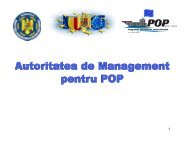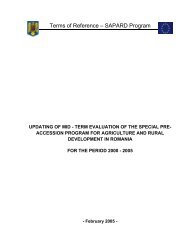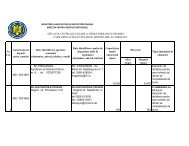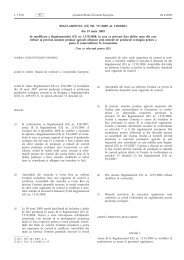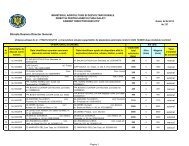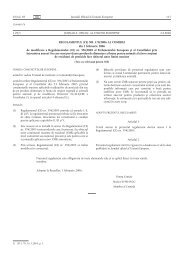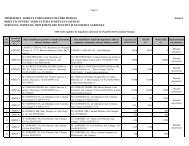Annex: Methodology 1 STRATEGY - MADR
Annex: Methodology 1 STRATEGY - MADR
Annex: Methodology 1 STRATEGY - MADR
Create successful ePaper yourself
Turn your PDF publications into a flip-book with our unique Google optimized e-Paper software.
Updating of Mid-Term Evaluation of SAPARD in Romania for the period 2000-2005• characteristics of the beneficiaries (location, average dimensions, etc.);• reaction of the potential beneficiaries (effective beneficiary enterprises of the totalpotential beneficiary enterprises);• capacity of qualitative improvement of supply;• decisions consequent upon the measures (increase in jobs).The Impact Indicators measure the specific impact, consequent upon the outputs and theresults obtained, and the global impact, consequent upon the specific objectives achieved. Themid-term evaluations update focus on the specific impacts; as it is the task of the ex-postevaluation to pay more attention to the global impact.The capacity of the monitoring service to provide the information necessary to support it andconsequently to complete the finalization of the system to collect the primary data, is assed.1.3.3 Sources of dataA first source of information is represented by the monitoring results, by earlier investigationsand studies, and by the information contained in the programming documents. In particular, theaforesaid source has been suitable for providing data of procedural and financial type, and theresults obtained during programme implementation. The secondary data are integrated withstatistical information provided by Qs surveys combined with basic information linked to thelocal context and in particular that of the sector.The direct collection by the Evaluator of the primary data has been a central element of theevaluation system as it makes it possible to obtain original information targeted on theperformance of the service whose qualitative level is closely connected with the functionality ofthe collection. A fair part of the primary data comes from the direct beneficiaries and therepresentativeness of the results guarantees its capacity to provide the programme results andimpacts.Below the data surveyed are classified in homogeneous categories according to the nature ofthe datum, survey source and connection with the individual indicators in the various chaptersof the CEQ, so as to clarify the Evaluator’s approach to the construction of the data surveysystem and to the integration of the sources of primary and secondary data.Nature of DatumSurvey sourcesReference toChapters of theCEQData of an economic, financial,structural and productive nature (levelof use of means of production such aswater, fertilisers, pesticides) relating tothe farms and forestry units, and toinformation regarding the “labour”factor within them.Analytical data relating to thequantitative and qualitative availabilityof ground waters and surface waters.Data relating to the impacts on thenatural systems bordering on thecultivated areas and concerned by themeasures, including data relating tostructural and qualitative aspects of• Monitoring Committee;• Direct inquiries on farms (interviews,questionnaires, case studies);• FADN;• National and regional accountingstatistics• Planning documents.• Monitoring Committee;• Direct inquiries on farms (interviews,questionnaires, case studies);• Sample analytical surveys.• Monitoring Committee;• Targeted investigations conductedoutside of farms (sampling, testareas);• National and regional statistics;Chapter AChapter CChapter AChapter AChapter C13



